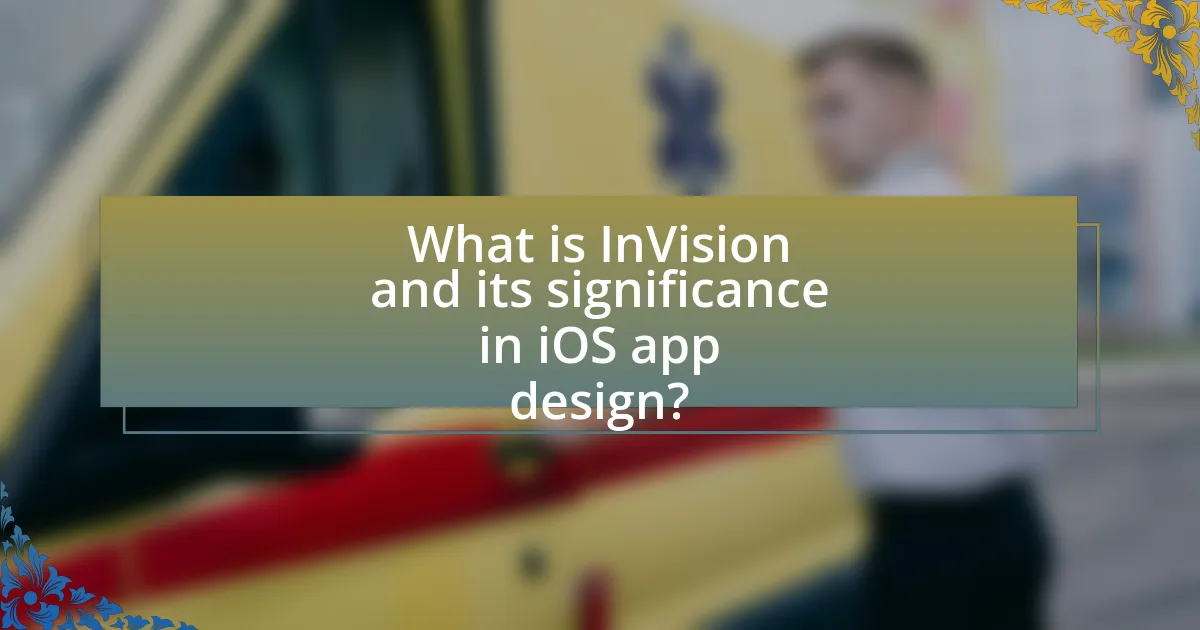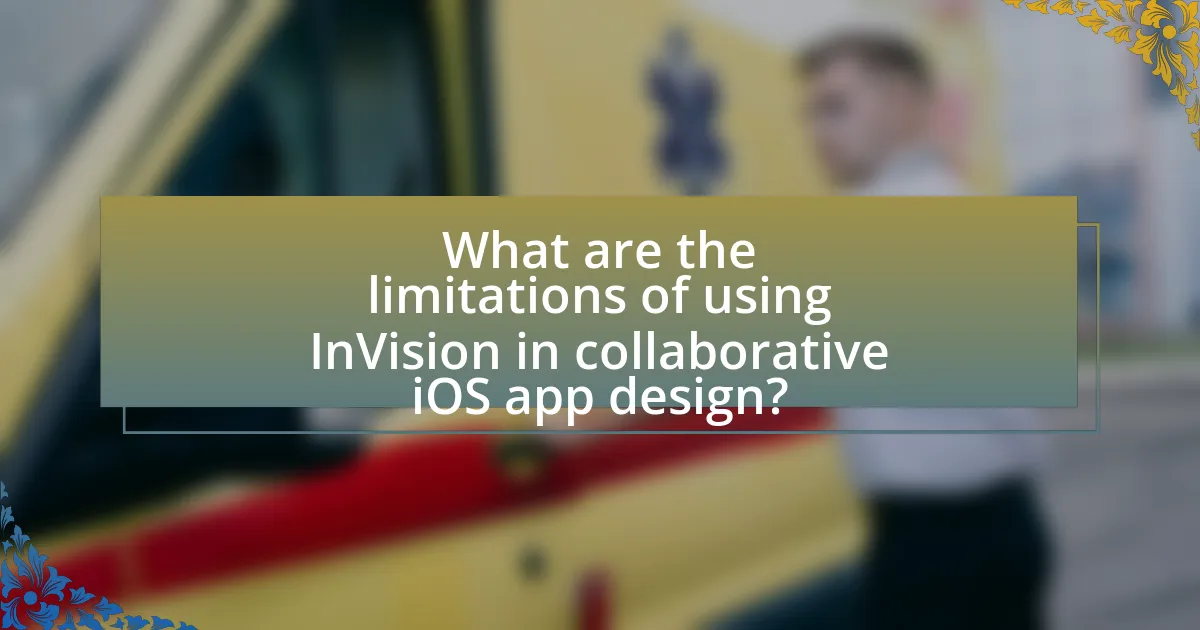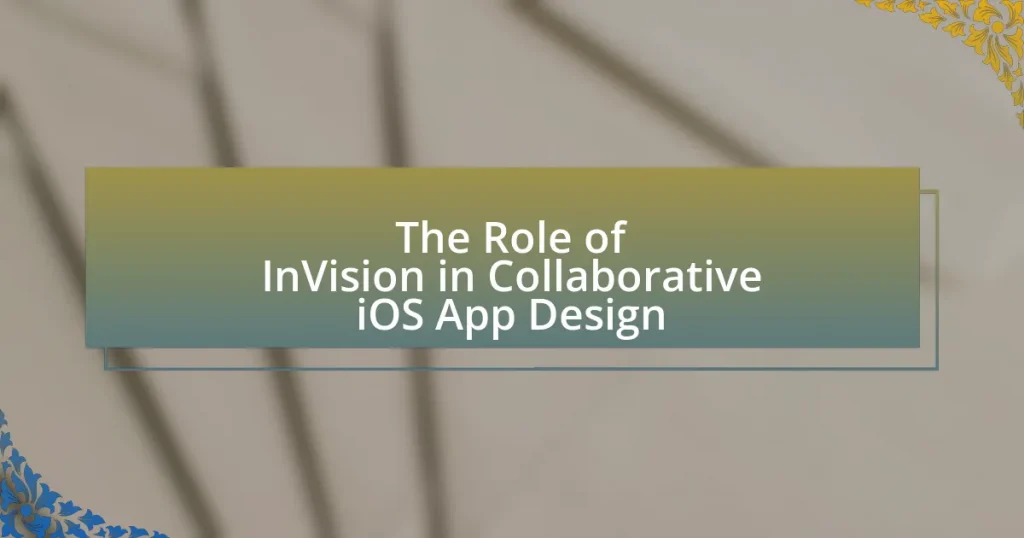InVision is a digital product design platform that plays a crucial role in collaborative iOS app design by enabling designers to create interactive prototypes and streamline the design process. The article explores InVision’s significance in enhancing team collaboration through features such as real-time feedback, version control, and integration with design tools. It discusses the importance of collaborative design in improving creativity and innovation, the challenges teams face without collaborative tools, and best practices for maximizing InVision’s capabilities. Additionally, the article addresses the limitations of InVision, alternative tools available, and future trends in collaborative design technology.

What is InVision and its significance in iOS app design?
InVision is a digital product design platform that enables designers to create interactive prototypes and collaborate effectively on design projects. Its significance in iOS app design lies in its ability to streamline the design process, allowing teams to visualize and test user interfaces before development. InVision supports features such as real-time collaboration, feedback collection, and version control, which enhance communication among team members and stakeholders. According to a survey by InVision, 94% of designers reported that using prototyping tools like InVision improved their workflow and efficiency, highlighting its critical role in modern iOS app design.
How does InVision facilitate collaboration among design teams?
InVision facilitates collaboration among design teams by providing a centralized platform for design sharing, feedback, and project management. The platform allows team members to create interactive prototypes, which can be easily shared with stakeholders for real-time feedback. Additionally, InVision includes features such as comment threads directly on design elements, enabling clear communication and reducing the need for lengthy email exchanges. The integration of tools like InVision Boards and Design Systems further streamlines collaboration by allowing teams to organize assets and maintain consistency across projects. These functionalities enhance teamwork and ensure that all members are aligned throughout the design process.
What tools does InVision provide for real-time feedback?
InVision provides several tools for real-time feedback, including InVision Cloud, which allows team members to comment directly on designs, and the InVision Inspect feature, which enables developers to view design specifications and assets. These tools facilitate collaboration by allowing users to leave comments, tag team members, and track feedback in a centralized platform, ensuring that all stakeholders can contribute to the design process efficiently.
How does InVision support version control in design projects?
InVision supports version control in design projects by allowing designers to create and manage multiple iterations of their work within a single platform. This functionality enables teams to track changes, revert to previous versions, and maintain a clear history of design modifications. InVision’s version control features include the ability to comment on specific design elements, facilitating feedback and discussions directly on the design files, which enhances collaboration and ensures that all team members are aligned on the latest updates.
Why is collaborative design important in iOS app development?
Collaborative design is important in iOS app development because it enhances creativity and innovation through diverse input from team members. When designers, developers, and stakeholders work together, they can share unique perspectives and expertise, leading to more effective problem-solving and improved user experiences. Research indicates that teams employing collaborative design processes are 30% more likely to produce successful products, as they can quickly iterate on ideas and incorporate feedback. This collective approach not only streamlines the development process but also ensures that the final product aligns closely with user needs and business goals.
What challenges do teams face without collaborative tools?
Teams face significant challenges without collaborative tools, including communication breakdowns, decreased productivity, and difficulty in tracking project progress. Communication breakdowns occur as team members may rely on emails or messages that can be easily overlooked, leading to misunderstandings and delays. Decreased productivity results from the lack of real-time collaboration, which can slow down decision-making processes and hinder the ability to share ideas quickly. Additionally, without collaborative tools, tracking project progress becomes cumbersome, as teams may struggle to maintain a clear overview of tasks and responsibilities, leading to missed deadlines and project goals. These challenges highlight the importance of collaborative tools in enhancing team efficiency and effectiveness.
How does collaboration enhance the design process?
Collaboration enhances the design process by fostering diverse perspectives and skills, which leads to more innovative solutions. When team members from various disciplines, such as UX design, development, and marketing, work together, they can share insights that improve the overall quality of the design. For instance, a study by the Design Management Institute found that companies that prioritize design collaboration outperform their competitors by 228% over ten years. This statistic underscores the tangible benefits of collaborative efforts in achieving superior design outcomes.

How does InVision integrate with iOS app design workflows?
InVision integrates with iOS app design workflows by providing a collaborative platform that allows designers to create, prototype, and share interactive designs seamlessly. This integration enhances the design process through features such as real-time feedback, version control, and easy sharing of prototypes with stakeholders. InVision’s compatibility with design tools like Sketch and Adobe XD further streamlines the workflow, enabling designers to import their work directly into InVision for prototyping and collaboration. This functionality is supported by over 5 million users who leverage InVision to improve communication and efficiency in their design projects.
What features of InVision are specifically beneficial for iOS designers?
InVision offers several features that are specifically beneficial for iOS designers, including prototyping, collaboration tools, and design handoff capabilities. Prototyping allows iOS designers to create interactive mockups that simulate the user experience on iOS devices, enabling them to test and iterate designs effectively. Collaboration tools facilitate real-time feedback and communication among team members, which is crucial for aligning design goals and making necessary adjustments quickly. Additionally, the design handoff feature streamlines the transition from design to development by providing developers with the necessary specifications and assets, ensuring that the final product aligns closely with the original design vision. These features collectively enhance the efficiency and effectiveness of the design process for iOS applications.
How does InVision’s prototyping feature improve user testing?
InVision’s prototyping feature enhances user testing by allowing designers to create interactive and realistic simulations of their applications. This interactivity enables users to engage with the prototype as they would with the final product, providing valuable insights into usability and functionality. Research indicates that interactive prototypes lead to more accurate feedback, as users can better express their thoughts and experiences when interacting with a tangible representation of the design. This results in more effective identification of usability issues and user preferences, ultimately improving the overall design process.
What role does InVision play in the handoff process to developers?
InVision facilitates the handoff process to developers by providing a platform that streamlines design specifications and assets. This tool allows designers to create interactive prototypes and share design files, which developers can access to view measurements, colors, and styles directly. InVision’s features, such as design version control and comment threads, enhance collaboration by ensuring that developers have the most up-to-date information and can communicate effectively with designers. This integration reduces misunderstandings and accelerates the development process, ultimately leading to a more efficient workflow in collaborative iOS app design.
How can teams maximize the use of InVision in their projects?
Teams can maximize the use of InVision in their projects by leveraging its collaborative features, such as real-time feedback, prototyping, and design handoff. Utilizing real-time feedback allows team members to comment directly on designs, facilitating immediate communication and reducing the time spent on revisions. Prototyping enables teams to create interactive mockups, which helps in visualizing user flows and gathering user insights early in the design process. Additionally, the design handoff feature streamlines the transition from design to development by providing developers with the necessary specifications and assets, ensuring that the final product aligns closely with the original design vision. These functionalities collectively enhance collaboration, improve efficiency, and lead to a more cohesive final product.
What best practices should teams follow when using InVision?
Teams should follow several best practices when using InVision to enhance collaboration in iOS app design. First, maintaining clear communication is essential; teams should utilize InVision’s comment feature to provide specific feedback directly on designs, ensuring that all team members are aligned on changes and expectations. Second, establishing a consistent design system within InVision helps streamline the design process, as it allows teams to reuse components and maintain visual coherence across the app. Third, regularly updating prototypes and sharing them with stakeholders fosters continuous feedback, which is crucial for iterative design improvements. Lastly, utilizing InVision’s integration capabilities with tools like Slack and JIRA can enhance workflow efficiency by keeping all project-related discussions and tasks centralized. These practices collectively improve collaboration and productivity in the design process.
How can teams effectively gather and implement feedback using InVision?
Teams can effectively gather and implement feedback using InVision by utilizing its built-in commenting and collaboration features. InVision allows team members and stakeholders to leave comments directly on design prototypes, facilitating clear communication about specific elements. This targeted feedback can be organized and prioritized, enabling teams to address the most critical issues first. Additionally, InVision’s integration with project management tools helps track feedback implementation, ensuring that all suggestions are considered and acted upon. This structured approach to feedback collection and implementation enhances the overall design process, leading to improved outcomes in collaborative iOS app design.

What are the limitations of using InVision in collaborative iOS app design?
InVision has several limitations in collaborative iOS app design, primarily related to its functionality and integration capabilities. One significant limitation is that InVision does not support real-time collaboration, which can hinder immediate feedback and iterative design processes among team members. Additionally, the platform may struggle with complex animations and interactions, which are crucial for iOS app design, leading to potential misinterpretations of the final product. Furthermore, InVision’s integration with other design tools can be limited, restricting seamless workflows and data transfer between applications. These factors can impede the efficiency and effectiveness of collaborative efforts in iOS app design.
What common challenges do users face with InVision?
Users commonly face challenges with InVision related to performance issues, limited integration options, and a steep learning curve. Performance issues often manifest as slow loading times and lag during collaboration, which can hinder productivity. Limited integration options restrict users from seamlessly connecting InVision with other tools they rely on, such as project management software. Additionally, the steep learning curve can be a barrier for new users, as mastering the platform’s features requires time and effort, which can delay project timelines. These challenges have been noted in user reviews and feedback across various forums and platforms, highlighting the need for improvements in these areas.
How can teams overcome these challenges?
Teams can overcome challenges in collaborative iOS app design by utilizing InVision’s features for effective communication and feedback. InVision provides tools such as real-time collaboration, which allows team members to share ideas and receive instant feedback, thereby reducing misunderstandings and streamlining the design process. Additionally, the platform’s prototyping capabilities enable teams to visualize concepts and iterate quickly, which is essential for addressing design challenges efficiently. Research indicates that teams using collaborative design tools like InVision report a 30% increase in productivity and a 25% reduction in project timelines, demonstrating the effectiveness of these strategies in overcoming design-related obstacles.
What alternatives to InVision exist for collaborative design?
Figma, Adobe XD, Sketch, and Marvel are prominent alternatives to InVision for collaborative design. Figma stands out due to its real-time collaboration features, allowing multiple users to work simultaneously on a design, which enhances teamwork and efficiency. Adobe XD offers integration with other Adobe products and supports co-editing, making it suitable for teams already using Adobe’s ecosystem. Sketch is favored for its extensive plugin library and strong community support, although it is primarily Mac-based. Marvel provides user testing and prototyping features, making it a versatile choice for design teams. Each of these tools offers unique functionalities that cater to different collaborative design needs.
What future trends can we expect in collaborative design tools like InVision?
Future trends in collaborative design tools like InVision include increased integration of artificial intelligence and machine learning to enhance design automation and user experience. These technologies will enable features such as predictive design suggestions and automated feedback, streamlining the design process. Additionally, the rise of real-time collaboration capabilities will facilitate seamless teamwork across different locations, allowing designers to work together more effectively. According to a report by Forrester Research, 70% of design teams are expected to adopt AI-driven tools by 2025, indicating a significant shift towards smarter design solutions.
How might advancements in technology impact collaborative design?
Advancements in technology significantly enhance collaborative design by facilitating real-time communication and seamless integration of tools. For instance, cloud-based platforms allow multiple designers to work simultaneously on a project, improving efficiency and creativity. According to a study by McKinsey & Company, teams that utilize digital collaboration tools can increase productivity by 20-30%. Furthermore, technologies such as virtual reality and augmented reality enable immersive design experiences, allowing stakeholders to visualize and interact with designs in innovative ways. These advancements not only streamline workflows but also foster a more inclusive and dynamic design process.
What features could enhance InVision’s role in iOS app design?
InVision could enhance its role in iOS app design by integrating real-time collaboration tools that allow multiple designers and stakeholders to work simultaneously on projects. This feature would facilitate immediate feedback and streamline the design process, making it more efficient. Additionally, incorporating advanced prototyping capabilities, such as interactive animations and transitions, would enable designers to create more dynamic and realistic app experiences. Research indicates that tools that support real-time collaboration can reduce project timelines by up to 30%, demonstrating the potential impact of these enhancements on productivity and design quality.
What are the best practices for effective collaboration using InVision?
The best practices for effective collaboration using InVision include utilizing the platform’s commenting feature for real-time feedback, organizing design files into clear project structures, and integrating with tools like Slack for seamless communication. These practices enhance team engagement and streamline the design process. For instance, InVision’s commenting system allows team members to leave specific feedback directly on design elements, which improves clarity and reduces miscommunication. Additionally, maintaining a well-organized project structure helps team members easily navigate and access necessary files, fostering efficiency. Integrating communication tools like Slack ensures that discussions about design changes happen in real-time, further enhancing collaboration.









